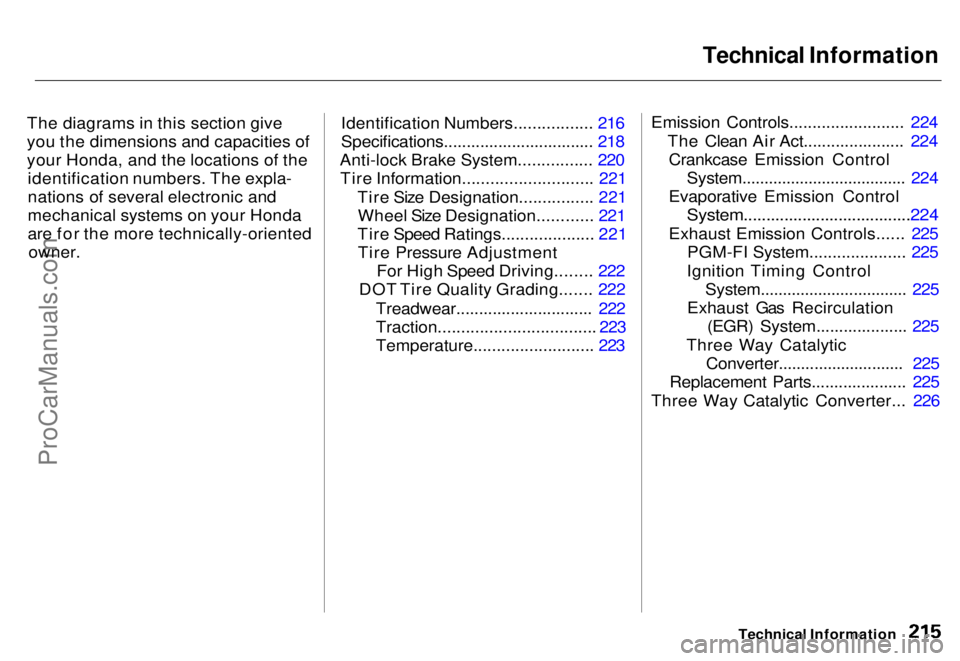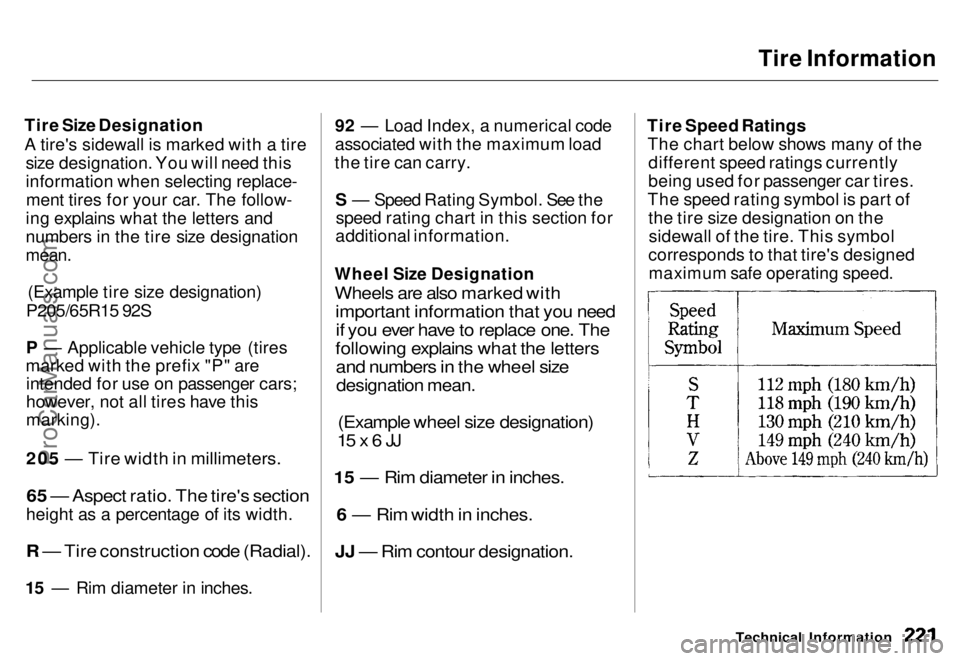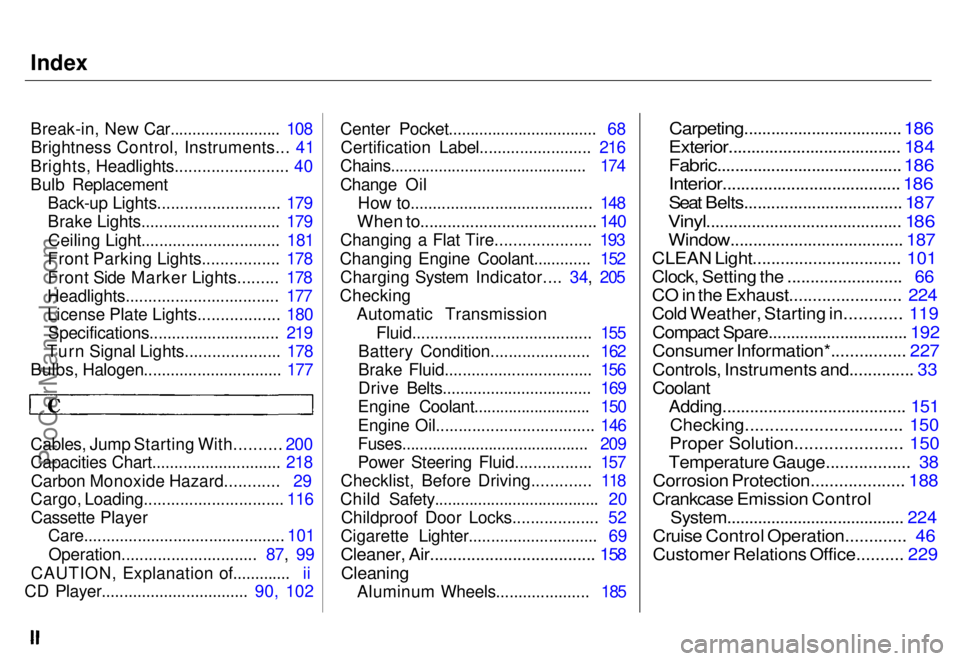1996 HONDA ODYSSEY wheel
[x] Cancel search: wheelPage 211 of 240

Towing
If your car needs to be towed, call a
professional towing service or, if you
belong to one, an organization that
provides roadside assistance. Never tow your car behind another car with
just a rope or chain. It is very
dangerous.
Emergency Towing
There are three popular methods of towing a car:
Flat-bed Equipment — The operator
loads your car on the back of a truck.
This is the best way of trans- porting your Honda.
Wheel Lift Equipment — The tow
truck uses two pivoting arms that go
under the tires (front or rear) and lift them off the ground. The other two
tires remain on the ground.
Sling-type Equipment — The tow
truck uses metal cables with hooks on the ends. These hooks go around
parts of the frame or suspension and
the cables lift that end of the car off
the ground. Your car's suspension and body can be seriously damaged
if this method of towing is attempted.
If your Honda cannot be transported by flat-bed, it should be towed with
the front wheels off the ground. Ifdue to damage, your car must be
towed with the front wheels on the ground, do the following:
Release the parking brake.Start the engine.
Shift to D4, then to N.
Turn off the engine.
Improper towing preparation will
damage the transmission. Follow the
above procedure exactly. If you cannot
shift the transmission or start the engine, your car must be transported
on a flat-bed.
It is best to tow the car no fartherthan 80 km (50 miles), and keepthe speed below 35 mph (55
km/h).
Trying to lift or tow your car by the
bumpers will cause serious damage.
The bumpers are not designed to
support the car's weight.
Taking Care of the Unexpected
NOTICE
NOTICEProCarManuals.comMain Menu s t Table of Contents
Page 212 of 240

Technical Information
The diagrams in this section give
you the dimensions and capacities of
your Honda, and the locations of the identification numbers. The expla-
nations of several electronic and
mechanical systems on your Honda
are for the more technically-orientedowner. Identification Numbers................. 216
Specifications................................. 218
Anti-lock Brake System................ 220 Tire Information............................ 221
Tire Size Designation................ 221Wheel Size Designation............ 221
Tire Speed Ratings.................... 221 Tire Pressure Adjustment For High Speed Driving........ 222
DOT Tire Quality Grading....... 222
Treadwear.............................. 222
Traction.................................. 223
Temperature.......................... 223 Emission Controls......................... 224
The Clean Air Act...................... 224Crankcase Emission Control System..................................... 224
Evaporative Emission Control
System.....................................224
Exhaust Emission Controls...... 225 PGM-FI System..................... 225
Ignition Timing Control System................................. 225
Exhaust Gas Recirculation (EGR) System.................... 225
Three Way Catalytic Converter............................ 225
Replacement Parts..................... 225
Three Way Catalytic Converter... 226
Technical InformationProCarManuals.comMain Menu s t
Page 217 of 240

Anti-lock Brake System
The Anti-lock Brake System (ABS) is standard equipment on all U.S.
models and the Canadian six-
passenger model. It is optional on the
Canadian seven-passenger model.
The ABS works by measuring how fast the wheels are turning during
braking and comparing their speeds.
If any wheel is rotating much slower
than the others (on the verge of locking up and skidding), the systemreduces hydraulic pressure to that
wheel's brake caliper. When that wheel's speed matches the other
wheels, the system applies normal
hydraulic pressure. This can take
place several times per second at
each wheel. You feel the ABS
working as rapid pulsations in the
brake pedal.
Each wheel has a wheel speed
sensor assembly. As the wheel
rotates, the sensor sends electrical pulses to the ABS control unit. The
pulse frequency varies with the
wheel speed.
The electrical output of the ABS control unit is connected to the
modulator/solenoid unit. During
braking, the ABS control unit monitors the pulse frequencies from
the four wheels. When the control unit detects a wheel locking up, itenergizes the appropriate solenoid in
the modulator/solenoid unit. There are six solenoids: two for each front
wheel, and two for the rear wheels.
The energized solenoid reduces hydraulic pressure to one side of amodulator valve. This, in turn,
reduces hydraulic pressure in the
brake line going to the affected
wheel. When that wheel speeds up because of the reduced braking effort, the control unit de-energizes the solenoid. This builds hydraulic
pressure on the modulator valve.
The pressure increases in the hydraulic line to the wheel.
For the system to react quickly, the
modulator/solenoid unit must have
brake fluid under high pressure.
This is supplied by a piston-type accumulator that is pressurized by
an electric pump. A pressure-sensingswitch on the accumulator controls
this pump.
The control unit also contains error detection circuitry. It monitors the
operation of the wheel sensors,solenoids, pump, and electronics. If
the control unit detects any faults, it shuts off power to the pump motor
and solenoids, disabling the ABS.
The indicator on the instrument panel comes on. The brakes then
work like a conventional system
without anti-lock capabilities.
Technical InformationProCarManuals.comMain Menu s t Table of Contents
Page 218 of 240

Tire Information
Tire Size Designation
A tire's sidewall is marked with a tire size designation. You will need this
information when selecting replace-ment tires for your car. The follow-
ing explains what the letters and
numbers in the tire size designation
mean.
(Example tire size designation)
P205/65R15 92S
P — Applicable vehicle type (tires
marked with the prefix "P" are intended for use on passenger cars;
however, not all tires have this
marking).
205 — Tire width in millimeters.
65 — Aspect ratio. The tire's section
height as a percentage of its width.
R — Tire construction code (Radial).
15 — Rim diameter in inches. 92 — Load Index, a numerical code
associated with the maximum load
the tire can carry.
S — Speed Rating Symbol. See thespeed rating chart in this section for
additional information.
Wheel Size Designation
Wheels are also marked with important information that you needif you ever have to replace one. The
following explains what the letters and numbers in the wheel size
designation mean.
(Example wheel size designation)
15
x
6
JJ
15 — Rim diameter in inches.
6 — Rim width in inches.
JJ — Rim contour designation.
Tire Speed Ratings
The chart below shows many of the different speed ratings currently
being used for passenger car tires.
The speed rating symbol is part of the tire size designation on thesidewall of the tire. This symbol
corresponds to that tire's designed
maximum safe operating speed.
Technical InformationProCarManuals.comMain Menu s t Table of Contents
Page 220 of 240

Tire Information
Traction
The traction grades, from highest to lowest, are A, B, and C, and they
represent the tire's ability to stop on
wet pavement as measured under controlled conditions on specified
government test surfaces of asphalt and concrete. A tire marked C may
have poor traction performance.
Warning: The traction grade as- signed to this tire is based on brak-
ing (straight ahead) traction tests and does not include cornering (turning) traction. Temperature
The temperature grades are A (the highest), B, and C, representing the
tire's resistance to the generation of
heat and its ability to dissipate heat
when tested under controlledconditions on a specified indoor
laboratory test wheel. Sustained high
temperature can cause the material of the tire to degenerate and reduce
tire life, and excessive temperature can lead to sudden tire failure. The
grade C corresponds to a level of
performance which all passenger car
tires must meet under the Federal Motor Vehicle Safety Standard No.109. Grades B and A represent
higher levels of performance on the laboratory test wheel than theminimum required by law. Warning: The temperature grade for
this tire is established for a tire thatis properly inflated and not over-
loaded. Excessive speed, underinfla-
tion, or excessive loading either separately or in combination, can
cause heat build-up and possible tire
failure.
Technical InformationProCarManuals.comMain Menu s t Table of Contents
Page 232 of 240

Index
Accessories
Installation.................................. 115
ACCESSORY (Ignition Key
Position)........................................ 50
Adding Automatic Transmission
Fluid........................................ 155
Brake Fluid................................. 156
Engine Coolant........................... 151
Engine Oil................................... 146
Power Steering Fluid................. 157
Windshield Washer Fluid......... 154
Additional Safety Information........ 18
Door Locks................................... 19Driving with Pets......................... 19
Head Restraint Position.............. 18
Seat-back Position........................ 18
Storing Cargo Safely................... 19
Additives, Engine Oil..................... 148
Adjustments
Mirrors.......................................... 64
Head Restraints........................... 56
Seats.............................................. 54
Steering Wheel............................ 44
Airbag (SRS).................................... 12
Air Cleaner..................................... 158
Air Conditioning............................... 74
Maintenance............................... 168
Usage............................................. 74
Air Outlets (Vents).......................... 76
Air Pressure, Tires........................ 170
Alcohol and Drugs........................... 28
Alcohol in Gasoline........................ 108
Antifreeze....................................... 150
Anti-lock Brakes (ABS)
Description................................. 220
Indicator Light..................... 35, 125
Operation.................................... 125
Anti-theft Steering Column Lock.. 49
Appearance Care........................... 183
Ashtray.............................................. 69
Audio System................................... 83
Automatic Speed Control................ 48
Automatic Transmission............... 120
Capacity, Fluid........................... 218
Checking Fluid Level................ 155
Shifting........................................ 120
Shift Lever Positions................. 120
Shift Lock Release..................... 123 Battery
Charging System Light............... 34
Jump Starting............................. 200 Maintenance............................... 162
Specifications............................. 219
Before Driving............................... 107
Belts, Seat........................................... 5
Beverage Holder.............................. 66
Body Repair.................................... 189
Brakes Anti-lock System (ABS)............ 125Break-in, New Linings .............. 108
Fluid............................................ 156
Light, Burned-out...................... 179
Parking.......................................... 65
System Indicator.......................... 34
Wear Indicators......................... 124
Brakes, ABS Description................................. 220Operation.................................... 125
System Indicator.................. 35, 125
Braking System.............................. 124
CONTINUEDProCarManuals.comMain Menu s t
Page 233 of 240

Index
Break-in, New Car......................... 108
Brightness Control, Instruments... 41
Brights, Headlights......................... 40
Bulb Replacement Back-up Lights........................... 179
Brake Lights............................... 179
Ceiling Light............................... 181
Front Parking Lights................. 178
Front Side Marker Lights......... 178
Headlights.................................. 177
License Plate Lights.................. 180 Specifications............................. 219
Turn Signal Lights..................... 178
Bulbs, Halogen............................... 177
Cables, Jump Starting With.......... 200
Capacities Chart............................. 218
Carbon Monoxide Hazard............ 29
Cargo, Loading............................... 116
Cassette Player Care............................................. 101
Operation.............................. 87, 99
CAUTION, Explanation of............. ii
CD Player................................. 90, 102 Center Pocket.................................. 68
Certification Label......................... 216
Chains............................................. 174
Change Oil How to......................................... 148
When to....................................... 140
Changing a Flat Tire..................... 193
Changing Engine Coolant............. 152 Charging System Indicator.... 34, 205
Checking Automatic Transmission
Fluid........................................ 155
Battery Condition...................... 162
Brake Fluid................................. 156
Drive Belts.................................. 169
Engine Coolant........................... 150
Engine Oil................................... 146
Fuses........................................... 209
Power Steering Fluid................. 157
Checklist, Before Driving............. 118
Child Safety...................................... 20 Childproof Door Locks................... 52
Cigarette Lighter............................. 69
Cleaner, Air.................................... 158
Cleaning
Aluminum Wheels..................... 185
Carpeting................................... 186
Exterior...................................... 184
Fabric......................................... 186
Interior....................................... 186
Seat Belts................................... 187
Vinyl........................................... 186
Window...................................... 187
CLEAN Light................................ 101
Clock, Setting the .........................
66
CO in the Exhaust........................
224
Cold Weather, Starting in............ 119
Compact Spare............................... 192
Consumer Information*................ 227
Controls, Instruments and.............. 33
Coolant
Adding........................................
151
Checking................................ 150
Proper Solution......................
150
Temperature Gauge.................. 38
Corrosion Protection.................... 188
Crankcase Emission Control
System........................................ 224
Cruise Control Operation............. 46
Customer Relations Office.......... 229ProCarManuals.comMain Menu s t
Page 238 of 240

Index
Seats
Reclining the Second Seat.......... 59
Removing the Second Seats....... 57
Third Seat Access...................... 56
Serial Number................................ 216
Service Intervals*.......................... 140
Service Manual.............................. 233
Service Station Procedures.......... 110
Setting the Clock............................. 66
Shifting the Automatic
Transmission.............................. 120
Shift Lever Position Indicator...... 120
Side Marker Lights, Bulb
Replacement in.......................... 178
Signaling Turns................................ 41
Snow Tires...................................... 174
Solvent-type Cleaners.................... 184
Sound System................................... 83
Spare Tire
Inflating....................................... 192
Specifications............................. 219
Spark Plugs, Replacing................. 160
Specifications Charts..................... 218
Speed Control...................................
46
Speedometer.................................... 3 7
SR
S Indicator............................. 16,
34
START (Ignitio
n
Key Position)..... 50
Starting the Engine........................ 119 In Cold Weather at HighAltitude................................... 119
With a Dead Battery................. 200
Steam Coming from Engine......... 202
Steering Wheel
Adjustment................................... 44
Anti-theft Column Lock.............. 49
Stereo Sound System...................... 83 Storing Your Car............................ 182
Sunroof............................................. 63
Closing Manually....................... 207
Operation......................................
63
Supplemental Restrain t
System
Service Precautions..................... 17
Servicing....................................... 16
SRS Indicator.......................... 16, 34
System
Components................... .
12
Synthetic Oil................................... 148
Tailgate........................................... 52
Taillights, Changing Bulbs in....... 179
Taking Care of the Unexpected.. 191 Tape Player................................ 87, 99
Technical Descriptions Anti-lock Brake System............ 220Emission Control Systems........ 224
Three Way Catalytic
Converter................................ 226
Tire Information........................
221
Temperature Gauge....................... .
38
Tether Attachment Points.............. 26 Three Way Catalytic Converter... 226
Time, Setting the...........................
66
Tire Chains.................................... .
174
Tire, How to Change a Flat.......... 193
Tires................................................ 169 Air Pressure............................... 170
Checking Wear.......................... 171
Compact Spare........................... 192
DOT Tire Quality Grading....... 222
Inflation....................................... 170
CONTINUED
ProCarManuals.comMain Menu s t